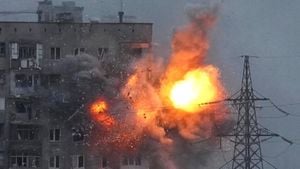Violent protests erupted in Katra, Jammu and Kashmir, over the proposed ₹250 crore ropeway project intended for the Vaishno Devi shrine, leading to clashes between local residents and police. The controversy surrounds the project aimed at significantly reducing the trek time for pilgrims accessing the shrine situated atop Trikuta hills. Local shopkeepers, pony and palki owners, are voicing their concerns about the adverse effects on their livelihoods, fearing job losses as the new infrastructure is set to change the dynamics of pilgrimage tourism.
On November 25, 2024, following several days of agitation, tensions escalated when protestors, part of the local community, clashed with security forces, leading to injuries on both sides. Reports indicate the protestors threw stones, which resulted in some damage to police vehicles, including one operated by the Central Reserve Police Force (CRPF). Eyewitness accounts shared by news agencies reveal stark scenes where protesters were seen throwing rocks as tensions boiled over.
The protests stem from rising frustration over the ropeway project, which is anticipated to allow pilgrims to complete the trek to the shrine within just six minutes. This project was announced by the Shri Mata Vaishno Devi Shrine Board (SMVDSB) as part of their efforts to cater to more than 90 lakh pilgrims expected by the end of the year—a significant increase from historic numbers when only around 14 lakh visited around the time the Shrine Board was established. Many locals express concerns over the detrimental effects, claiming it will bypass their businesses and undermine the years they spent developing various service offerings. With the initiation of this project also came the fear of unemployment; workers depend heavily on the foot traffic of pilgrims who rely on pony and palki services for transportation during their pilgrimage.
After several days of strikes, originally initiated by shopkeepers, pony-walas and palki owners starting November 22, 2024, the protest rallied for what was originally set as a 72-hour cease of their services, later extending for another 24 hours. The protestors assert they were not sufficiently consulted about the ropeway project, and many feel the local administration is acting as if they are irrelevant stakeholders. The resentment directed at Jammu's Lieutenant Governor, Manoj Sinha, who oversees the shrine board, has been palpable, with many locals accusing him of neglecting local interests.
A senior officer commented on the clashes, noting the significant challenge law enforcement faced as they attempted to manage the situation without exacerbation. "Officers are currently engaging with protest leaders to find amicable solutions to the growing unrest, and there is hope for restored calm as discussions progress,” said Senior Superintendent of Police (SSP) Paramvir Singh.
Following the confrontations, local authorities announced plans for negotiations, during which they assured protest leaders they would meet with various stakeholders within the following weeks. Many are awaiting updates on discussions promising to address the collective demands and concerns raised during the protests. One such meeting was already suggested to take place by December 15, as indicated by the Reasi District Commissioner, Vishesh Paul Mahajan.
Local businesses along the pilgrimage route, previously booming due to the influx of visitors, have been significantly affected by the protests. While some shops remained operational during the strike, others lining the popular pilgrimage path observed closures, directly causing hindrances for many who rely on services provided by pony-walas and palki owners. Many pilgrims have been left stranded, particularly the elderly, who find it increasingly difficult to navigate the trek without assistance.
Protest leaders expressed their continued commitment to ensuring their voices are heard. They plan to assemble before the District Magistrate's office again to press their demands and share grievances with relevant authorities. Members of the joint committee representing the shopkeepers and local service providers have confirmed they will take incremental steps should responses remain unsatisfactory.
The ropeway project is viewed by some as necessary modernization to meet the needs of increasing visitor numbers, framing it as not just about tourism enhancement but also job creation—at least for specific sectors. But for many who rely on traditional pilgrimage services, this is seen as sacrificing their livelihoods for commercial gain. Depending on how negotiations and discussions proceed, it remains to be determined how this infrastructural change will shape not just the future of pilgrimage tourism but the local economy as well.
Overall, the violent turn of events marks not just the urgency of local needs but also the broader tension between development projects and existing community livelihoods. The outcome of the coming discussions between local authorities and protestors could play a pivotal role in determining the future of Katra as both a pilgrimage site and community hub.



